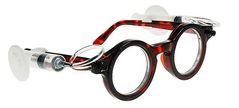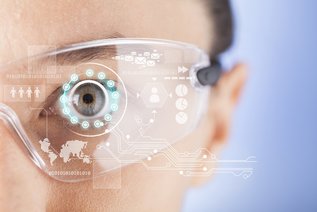
There has been a lot of research to improve the limitations of bifocal lenses and reduce the side effects - headaches, dizziness, muscle fatigue and the small field of view. Introduction of trifocals and progressive multifocal lenses did not solve all the problems.

Like self-adjustable glasses invented by Josh Silver (shown on the right). Fluid-filled lenses promise to correct a wide range of vision problems, including nearsightedness, farsightedness and inability to focus. No need to see an optometrist that most people in the developing world can't afford.The price of these glasses, however, remain too high even for the developed world - as the quality is still inferior to inexpensive off-the-shelf glasses that can be easily test-driven in the drug store.

8 years ago, adjustable-focus Superfocus' glasses with fluid-filled lenses, were introduced to the commercial market. They glasses required manual adjustment of the focus - by moving the slider on the nose bridge, looked "clunky and ugly", were priced at $900 (later discounted to about $600), but grew a loyal following. Nevertheless, the company went out of business, and several new companies since kept trying to step into the gap. Adlens and Dial Vision are now offering glasses adjustable for both near or far-sighted for less than $20 (shown on the right).

The inventors hope that after a few technological and styling improvements, the product will hit store shelves in two or three years.

Some of these technologies are slowly becoming mainstream. Google glass has showcased the potential of smart eyewear. Microsoft's patent suggested to use glasses to detect other people's emotions. AVG glasses use infrared light to recognize faces. Dispelix brings visual information directly into the user's field of vision, to prevent eye strain. X-ray glasses from Even Medical enable to see veins. BMW is developing glasses to help with driving. Virtual reality is still boutique technology, but is gaining steam. A recent paper showed that Augmented Reality - when an Unmanned Aerial Vehicle operator can see both the mission plan as well as the video stream captured by the drone - significantly improved situational awareness.
New and exciting technologies are unfolding before our eyes. So, perhaps, smart glasses will come back smarter - letting us see the world like we've never seen before.
 RSS Feed
RSS Feed
